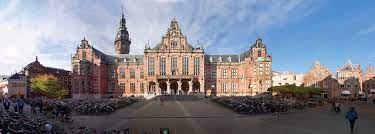University of Groningen: Expedition set to begin, weather and polar bears permitting
Two years later than planned as a consequence of the coronavirus pandemic, Maarten Loonen of the Arctic Centre of the UG has once again set sail for Spitsbergen to embark on a second, large-scale ‘SEES expedition’. Fifty researchers and as many ‘citizen scientists’ are about to experience first-hand how climate change affects the Arctic region.
‘We can’t do it. It’s impossible.’ The announcement made by expedition leader Jan Belgers is as clear as it is disappointing. Oceanwide Expeditions’ ship Ortelius lies a few hundred metres off the coast of the island Edgeøya, on the east side of the Spitsbergen archipelago. Using binoculars, we can see big waves hitting the shore. ‘It would be irresponsible to land our zodiacs through such breakers’, Belgers implores. And as if that wasn’t enough of a problem, there are also two tiny off-white spots on the rocky slope – a polar bear with an adolescent cub. ‘These polar bears live here. We are merely visitors. And we do not want to consciously risk having to chase the bear off because it comes too close to our group. Or worse. In other words: we cannot go ashore’, Belgers announces over the ship’s intercom.
‘So this is what climate change does’, Loonen says in a somewhat resigned way. ‘During the previous Scientific Ecological Expedition Svalbard (SEES) in August 2015, we had difficulty landing our rubber dinghies here because of all the sea ice. Now, and it is even a month earlier in the year, there is no sea ice to be found anywhere around Spitsbergen. This also means that the waves are damped to a much lesser extent and thus break much harder on the shore.’
In addition, the number of polar bears on the islands is higher than usual. ‘Polar bears prefer to live and hunt on the ice. But now that the ice is melting so fast, they are more or less trapped on the little islands. They can’t get off, and we can’t get on.’
Polar bear in island Edgeøya Polar bear in Edgeøya
Glacier excursion
In addition to organizing this major polar expedition, Loonen would also like to do some research on and around the island of Edgeøya. ‘For example, a few colleagues and I would like to go back to the Rosenbergdalen region’, he says. ‘This is where the very first scientists here did their research. One of those four original Dutch researchers, Ko de Korte, is now 79 years old and he is joining this current expedition too. They carefully charted the vegetation there in 1977, and we did the same in 2015. We would now like to repeat this process to see whether there are any changes. But we can only do this if the weather is good and there are no polar bears in the way.’
Later in the week, the expedition leader will re-examine whether the conditions near the Rosenbergdalen valley are good enough to safely go ashore. Plan B has been put in place for this day: a visit by zodiac to the mouth of the impressive Negribreen glacier. The variously sized chunks of ice that fall from the sliding glacier into the sea compensate the lack of sea ice somewhat, so that the visitors will still get the ‘Arctic feeling’ in the midst of a rapidly warming and changing landscape.

